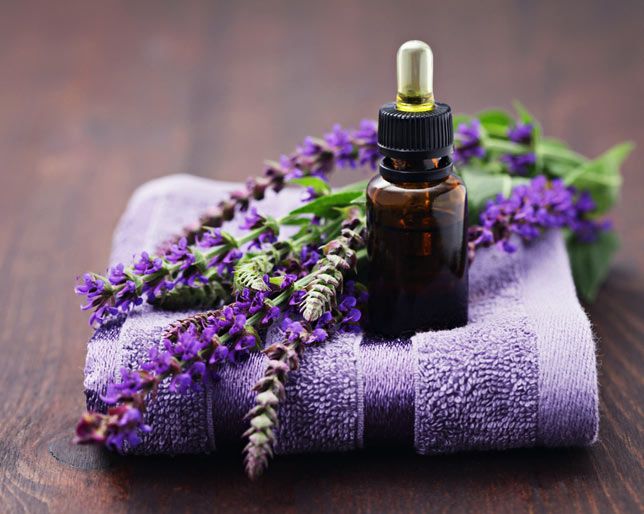If you’re looking for way to level up your QT with your S.O., try giving them a massage. Sure, if you’re not a professional, figuring out how to give a massage without hurting them, or worse going too soft (yikes) might seem tricky. But it’s worth it.
Physical touch can not only up the intimacy of your relationship, but it can also help your partner decompress, and get rid of some of their stress, says Ashley Dwyer, licensed massage therapist in North Carolina and author of Massage for Couples: Heal, Soothe, and Connect with the One You Love. “Sometimes when we get in a space of living in our head instead of the present, we have increased anxiety. The reason that reduced anxiety is a benefit of massage is its grounding factor,” says Dwyer. By relaxing the body, our relationships can more easily recover from the stresses and strains of every day life.
Dwyer also points out that massage caters to every one of the five love languages, not just physical touch. “It is quality time, since it cannot be fulfilled virtually, it is an act of service, it encourages words of affirmation because you have to communicate, and it can even be initiated with a gift, such as a book about massage, a nice essential oil or a special massage lotion.”
The physical touch aspect in particular can help you deepen your relationship. “The more [comfortable you are] with someone in your body and your skin and being vulnerable, the more that relationship is going to grow in intimacy and connection,” says Dwyer. Plus, there’s that boost your self esteem will get from the validation your partner offers throughout.
Aside from all these benefits, getting a massage just plain feels good. So, if you want to treat your partner to something special, here are seven tips to make you a massage-giving pro.
1. Perform the massage somewhere you’re comfortable.

In a newer relationship, a massage can be a sign of support. Dwyer says some couples may be okay with a small public displays of affection like massaging the neck or the shoulder or the back while out at a public event or shopping. But before doing this, you always want to make sure you’ve received clear consent that your partner is okay with you touching them.
In a more intimate relationship, Dwyer says you may want to your massage to take place at home. “You can rub each other’s feet on the living room couch watching TV…,” she suggests. You’ll want to choose a place that’s comfortable, so Dwyer recommends avoiding spaces withchaos that can also be distracting, like noisy rooms, or rooms with clutter.
2. You can use props, like music and candles to set the mood.
Once you’ve picked your location, you’re going to want to elevate your setting by playing soft instrumental music (something with words may be distracting), lighting a candle, or using essential oils. Doing this can make your partner focus on the here and now by appealing to their senses, says Dwyer. You’ll also want to eliminate distractions by turning devices, like your phone and the TV, off. Dwyer also suggests sticking with dim lighting, so avoid any fluorescent lights.
3. Make sure you’ve got the right tools, like lotions or massage oils, on hand.


First things first, you should check in to see if your partner has any allergies, and if they do, carefully read ingredients.”You don’t want to use sweet almond oil and then find out they have a nut allergy,” says Dwyer. You also want to keep things in a nearby basket or drawer for easy accessibility. “Prepare ahead of time or keep things handy for when you intend to break them out,” Dwyer suggests.
Some options of massaging tools include essential oils, lotions you can gently microwave, or massage candles, though Dwyer says you want to keep mindful of their temperatures. “Test it on yourself before putting it on them. There is nothing that will literally ruin the moment like a burn,” say Dwyer.
4. Let your partner determine the pressure.
You can ask them if it’s too much or not enough. “If they tense up or wince it’s probably a sign that they are uncomfortable,” says Dwyer. “…You never want to intentionally hurt each other, even playfully.”
Though you don’t want to push your hands into your partner so much it’s uncomfortable, Dwyer says that there are a variety of strokes and techniques you can put to use. “Heavier pressure is good for tight muscles. A gentle firm touch may develop more trust and help your significant other relax more. A light touch can be much more sensual,” Dwyer explains.
She also adds that listening and communicating with your partner to figure out their needs can build deeper trust and connection.
5. Your best bet is to start at the neck.
But you can really start anywhere, since massage is pretty forgiving, says Dwyer. To properly massage the neck, Dwyer suggests having your partner sit in a chair or lie back with their head on the edge of a bed or in your lap. Then, you want to cradle their head and make gentle circles, or just hold the tight area where the head meets the neck. “This is often times where people get tension headaches and hold stress from being on zoom calls and the computer all day,” says Dwyer.
You can continue the neck massage by gently working your hands down the neck towards the shoulders by sweeping them downward slowly or continuing to make small circles using your finger tips.
Knots from a workout? Here’s how to get some relief?
6. Massaging the back might call for a few techniques.
Dwyer says that when massaging the back she likes to start at the neck with both hands on either side of the spine, while sliding her hands down to the top of the hips. You can also do this using your fists if you want to apply more pressure.
Dwyer says that the shoulders and upper body can usually take more pressure than the lower back, which can often feel more tender to your partner, so make sure to check in occasionally to make sure they’re comfortable.

Don’t be afraid to apply a bit more pressure when you find a spot that feels tight. To address that, Dwyer recommends trying some circular friction on the area. “Use your fingertips to rub the area lightly in a clockwise or counterclockwise motion until it feels like it’s freed up,” she says. Another option is to lightly pinch them. “You can also press into the area and hold the spot using a finger, thumb or fist until it relaxes and gives. Or pinch or roll [your fingers] along the area, lifting the muscle gently off the bone,” Dwyer says.
7. Go easy on the limbs, hands, and feet.
When you’re working on the arms and legs, you want to work towards the torso instead of away from it to support natural blood flow, Dwyer says. Another technique you can use is raking or sweeping the hands up the arms or legs with long smooth strokes. You can do this by taking two cupped hands on the outer or inner side of the extremity, picking the muscle tissue up (kind of like pinching) and pulling it together to help increase circulation.
When it comes to fingers and toes, you can try massaging with your fingers in tiny circles, or gently pulling on them, which Dwyer says can feel nicer than it sounds.
Source: Read Full Article